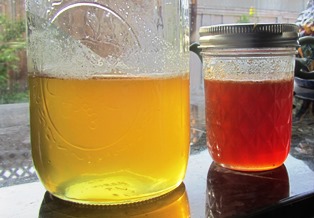Seasonal Flowers Change the Taste and Color of Honey
If you’ve ever wondered where honey gets its color and taste, think flowers. Or, more correctly, pollen from the flower and herb blooms and tree blossoms.
In the environs that encompasses roughly five to ten miles around the Henny Penny Farmette, honeybees gather pollen from blossoms on lavender, citrus, sunflowers, cosmos, fruit trees, and other flowering trees. Bees collect pollen from cultivated gardens but also from plants growing wild on hillsides and in the meadows and fields.
The first woodland flowers and wildflowers of spring yield honey that is a pale lemon color and tastes sweet and light. Later in the season, the pollen bees collect from citrus tree blooms such as orange blossoms becomes honey with citrus notes and aroma. When certain types of eucalyptus trees bloom in September, the honey takes on a warm amber color and a strong and earthy taste.
Dark honey is also found in a spring hive. It can be traced to the pollen that the bees have discovered and gathered from blossoms and blooms of flowers, trees, or herbs with a strong flavor and dark color.
If you want the health benefits from honey, purchase the raw honey. Raw honey is high in antioxidants and also has immune-boosting properties, according to Dr. Tasneem Bhatia, from the Atlanta Center for Holistic and Integrative medicine.
In a December 2012 appearance on the Dr. Oz show, Dr. Bhatia recommended people take 1 to 2 teaspoonfuls of buckwheat honey every day as a natural remedy for cold, sore throat, and flu symptoms. See, http://www.prweb.com/releases/honey/buckwheat-honey-raw/prweb10242276.htm
Raw honey means it has not been heated or otherwise adulterated by processes that reduce or compromise the healthy benefits. Beneficial enzymes, propolis, pollen, minerals, vitamins, amino acids, and antioxidants are destroyed when the honey is heated.
Drink your hot tea or warm milk with honey, but don’t put the honey in the cup of liquid and stick it into the microwave. Warm the liquid first, then add the honey.
It matters not whether your taste leans toward the light honey or the dark, the liquid honey or the honeycomb, have some honey every day. It’s good for you.
 Facebook
Facebook Goodreads
Goodreads LinkedIn
LinkedIn Meera Lester
Meera Lester Twitter
Twitter





